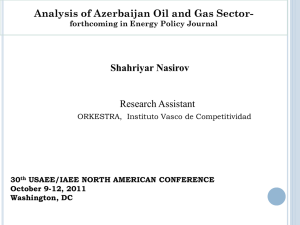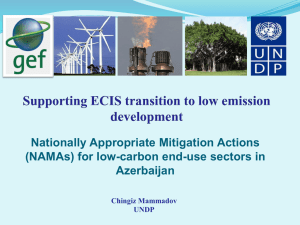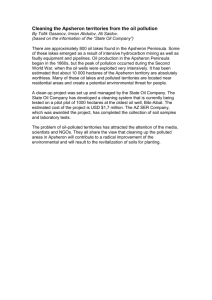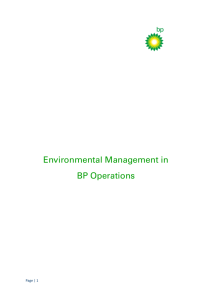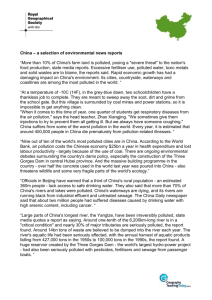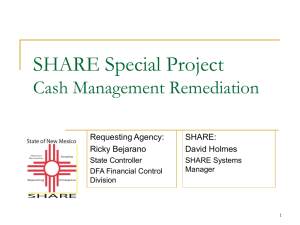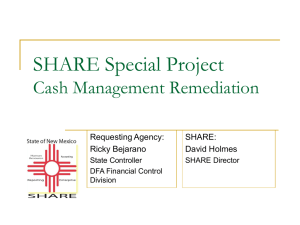Integrated Safeguards Data Sheet
advertisement
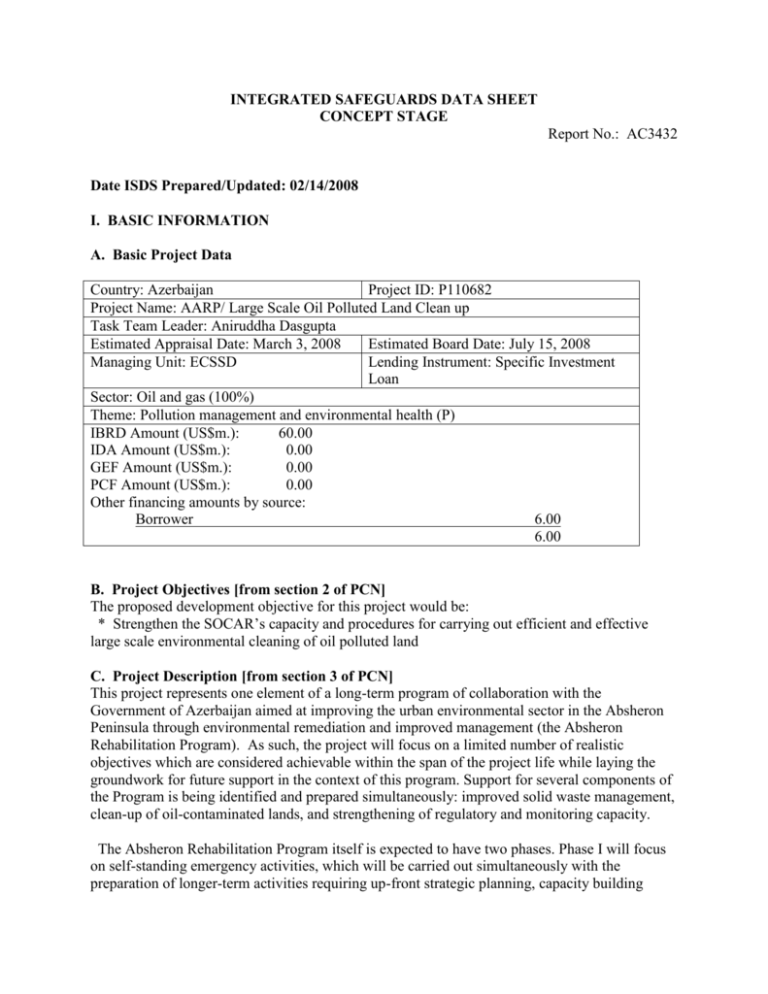
INTEGRATED SAFEGUARDS DATA SHEET CONCEPT STAGE Report No.: AC3432 Date ISDS Prepared/Updated: 02/14/2008 I. BASIC INFORMATION A. Basic Project Data Country: Azerbaijan Project ID: P110682 Project Name: AARP/ Large Scale Oil Polluted Land Clean up Task Team Leader: Aniruddha Dasgupta Estimated Appraisal Date: March 3, 2008 Estimated Board Date: July 15, 2008 Managing Unit: ECSSD Lending Instrument: Specific Investment Loan Sector: Oil and gas (100%) Theme: Pollution management and environmental health (P) IBRD Amount (US$m.): 60.00 IDA Amount (US$m.): 0.00 GEF Amount (US$m.): 0.00 PCF Amount (US$m.): 0.00 Other financing amounts by source: Borrower 6.00 6.00 B. Project Objectives [from section 2 of PCN] The proposed development objective for this project would be: * Strengthen the SOCAR’s capacity and procedures for carrying out efficient and effective large scale environmental cleaning of oil polluted land C. Project Description [from section 3 of PCN] This project represents one element of a long-term program of collaboration with the Government of Azerbaijan aimed at improving the urban environmental sector in the Absheron Peninsula through environmental remediation and improved management (the Absheron Rehabilitation Program). As such, the project will focus on a limited number of realistic objectives which are considered achievable within the span of the project life while laying the groundwork for future support in the context of this program. Support for several components of the Program is being identified and prepared simultaneously: improved solid waste management, clean-up of oil-contaminated lands, and strengthening of regulatory and monitoring capacity. The Absheron Rehabilitation Program itself is expected to have two phases. Phase I will focus on self-standing emergency activities, which will be carried out simultaneously with the preparation of longer-term activities requiring up-front strategic planning, capacity building and/or extensive feasibility and environmental preparatory work. Phase II will focus on priority investments prepared in Phase I. Over the life of the program, the Bank would provide a total of $300 million in financing, of which $60 million would be required for Phase 1 of the Oil Polluted Land Clean up project’s investments. The project which is the subject of this ISDS (Large Scale Oil Polluted Land Clean up) represents Phase I of the oil polluted land clean up component of the Program. The project would be implemented by the State Oil Company of Azerbaijan (SOCAR) The objective of this project would be to improve the environmental conditions in the Absheron Peninsula by increasing SOCAR's capacity for cleaning up oil polluted land by i) developing a business plan for cleaning up 10,000 hectares of contaminated land; and ii) purchasing soilcleaning equipment which will substantially increase SOCAR's capacity to clean oil sludge and (iii) building and enhancing SOCAR’s own capabilities for technical remediation techniques and process management via a TA component. D. Project location (if known) The project is located on Absheron Peninsula, which today is heavily and extensively polluted due to nearly 150 years of oil production that has left some 10,000 hectares of oil-contaminated land. Oil production has been intense in many sectors of the Apsheron peninsula, where production facilities are often close to and entwined with residential, recreational and agricultural areas. The project focuses on oil fields within the main urban centers on Absheron, especially the vicinity of the Capital City of Baku on the southern coast. There are three areas where extremely high pollution levels, soil and contamination type, the proximity of settlements and infrastructure and the pressure on and potential values of land create favorable conditions for large scale project implementation. These areas are Bibi Heybat just south of the center of Baku and the areas Qala and Mashtaga-Buzovna to the West and Northwest of the capital. E. Borrower’s Institutional Capacity for Safeguard Policies [from PCN] The Presidential Decree and approved ESP signals high level commitment and has stimulated action by key ministries and agencies. It focuses primarily on the Absheron Peninsula, although some activities are national in scope. It is a comprehensive plan involving both cleanup/remediation and forward-looking environmental management. It addresses legacy contamination and on-going pollution, as well as hazardous and non-hazardous waste. For this project the implementing agency is the sate oil company SOCAR, which has recently created a task force within its environmental department dedicated explicitly to the remediation of past environmental liabilities. SOCAR has also created and environmental contractor, EKOL, to accomplish remediation and restoration works. The task force consists of engineers and specialists which are familiar with oil production and its environmental issues and are currently being trained in modern remediation approaches and management. They have secure technical support by experienced national and international Consultants which are providing analytical, design and planning services and technical assistance. The project, through several TA components, envisages further strengthening of SOCAR’s capacity for environmental and social due diligence and safeguards implementation during project implementation. F. Environmental and Social Safeguards Specialists Mr Frank Van Woerden (ECSSD) Ms Gulana Enar Hajiyeva (ECSSD) Mr Satoshi Ishihara (ECSSD) Mr Bakhtiyar Karimov (ECSSD) Mr Wolfhart Pohl (ECSSD) II. SAFEGUARD POLICIES THAT MIGHT APPLY Safeguard Policies Triggered Yes No TBD Environmental Assessment (OP/BP 4.01) X The Large Scale Oil Polluted Land Clean-up Project /component has been preliminarily classified as Category ‘B’. The project involves the purchase of soil cleaning equipment for remediation of oil contaminated land. While provision of the equipment is not high risk per se, the Safeguard approach must address the ways in which it is expected that SOCAR will use the equipment. SOCAR has prepared a feasibility study, an EIA, EMP, EMF and an Operation Plan for cleaning up of oil-contaminated land. The environmental documented so far appears to conform to good international practice and can be considered acceptable to Bank standards. Both EMF and an EMP have been reviewed by the team’s environmental specialist and found satisfactory regarding EA safeguard requirements. Key issues that are be addressed include the approach to prioritization of sites for clean-up, the nature and level of site investigations to be undertaken prior to beginning excavations (including identification of both surface and subsurface hazards), disposal of residue from soil cleaning, and categorization of levels to which given parcels would be cleaned (i.e. for what types of subsequent usage or development), as well as other aspects which directly influence cleanup costs and risks. Two consultations at the National level will have been conducted before appraisal on the general project as well as the EIA/EMP/EMF. Natural Habitats (OP/BP 4.04) X Forests (OP/BP 4.36) X Pest Management (OP 4.09) X Physical Cultural Resources (OP/BP 4.11) X Indigenous Peoples (OP/BP 4.10) X Involuntary Resettlement (OP/BP 4.12) X As some people have built houses close to or sometimes on oil-polluted land, cleaning up this land would require relocation of the residents. The Government and SOCAR have clearly agreed that no clean up activity will be carried out on land where people would need to be resettled. This is consistent with SOCAR’s recent practice where it has focused on vacant land, not areas where people would need to be resettled. Therefore the Policy is not triggered. Safety of Dams (OP/BP 4.37) X Projects on International Waterways (OP/BP 7.50) X Projects in Disputed Areas (OP/BP 7.60) X Environmental Category: B - Partial Assessment III. SAFEGUARD PREPARATION PLAN A. Target date for the Quality Enhancement Review (QER), at which time the PAD-stage ISDS would be prepared: 02/06/2008 B. For simple projects that will not require a QER, the target date for preparing the PAD-stage ISDS: N/A C. Time frame for launching and completing the safeguard-related studies that may be needed. The specific studies and their timing1 should be specified in the PAD-stage ISDS. One consultation at the National level has been be carried out already and a second one is planned before appraisal on EIA/EMF and EMP, which have been made as final draft versions. Documents for disclosure before appraisal: EIA, EMP, EMF. IV. APPROVALS Signed and submitted by: Task Team Leader: Approved by: Regional Safeguards Coordinator: Comments: Sector Manager: Comments: 1 Mr Aniruddha Dasgupta 02/12/2008 Ms Agnes I. Kiss 02/13/2008 Mr Wael Zakout 02/14/2008 Reminder: The Bank's Disclosure Policy requires that safeguard-related documents be disclosed before appraisal (i) at the InfoShop and (ii) in-country, at publicly accessible locations and in a form and language that are accessible to potentially affected persons.
